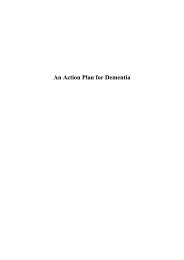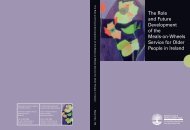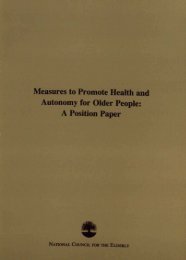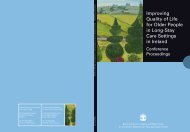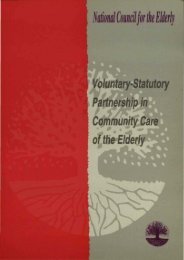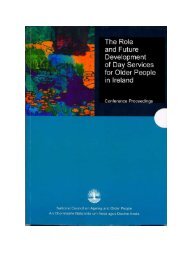From Ageism to Age Equality: Addressing the Challenges ...
From Ageism to Age Equality: Addressing the Challenges ...
From Ageism to Age Equality: Addressing the Challenges ...
Create successful ePaper yourself
Turn your PDF publications into a flip-book with our unique Google optimized e-Paper software.
Postal Survey of AttitudesWe conducted a postal survey of professional staff in <strong>the</strong> health and social services sec<strong>to</strong>r acrossIreland. The target population for this attitudinal assessment of ageism was any member of staffwho, through <strong>the</strong>ir working capacity, came in<strong>to</strong> contact with older people on a regular basis. Thesample frame for <strong>the</strong> research included professional staff in <strong>the</strong> acute hospital sec<strong>to</strong>r, <strong>the</strong> communityhospital sec<strong>to</strong>r and <strong>the</strong> primary care/community sec<strong>to</strong>r. Departments including Children’s Servicesand Gynaecology and Obstetrics were deemed ineligible for inclusion given <strong>the</strong>ir infrequent contactwith older people. Of <strong>the</strong> 95,679 health service providers included on <strong>the</strong> Department of Health andChildren Personnel Census of 2002, it was estimated that 70 per cent came in<strong>to</strong> contact with olderpeople on a regular basis. Therefore <strong>the</strong> target population was n=66,975 approximately. The desiredsample size for <strong>the</strong> attitudinal assessment of ageism was 2,250 health service providers. This originalsample requirement was stratified according <strong>to</strong> health board area and employment grouping on <strong>the</strong>basis of published employment figures from <strong>the</strong> Department of Health Personnel Census for 2002.34A process of consultation with health board CEOs and Direc<strong>to</strong>rs of Services for Older People was <strong>the</strong>ninitiated <strong>to</strong> acquire personnel details against those target figures identified above. On <strong>the</strong> basis ofinformation returned <strong>to</strong> <strong>the</strong> research team, 1,182 health service staff formed <strong>the</strong> eventual sampleframe for <strong>the</strong> study. <strong>From</strong> <strong>the</strong> sample frame N=1,182 stratified quota sampling was fur<strong>the</strong>r applied<strong>to</strong> <strong>the</strong> lists <strong>to</strong> identify 832 staff <strong>to</strong> whom postal questionnaires were issued while <strong>the</strong> remaining 250staff on <strong>the</strong> lists were invited <strong>to</strong> attend round-table discussions. Of <strong>the</strong> 832 staff sent questionnaires,698 completed returns. The response rate <strong>to</strong> <strong>the</strong> postal questionnaire was 84 per cent. Those whoattended <strong>the</strong> discussion groups were also provided with an opportunity <strong>to</strong> complete <strong>the</strong>questionnaires and 128 staff availed of this opportunity. As a result, <strong>the</strong> overall sample size for <strong>the</strong>questionnaire was 826.The survey questionnaire included questions from <strong>the</strong> Fraboni Scale of <strong><strong>Age</strong>ism</strong> (FSA), a scale thathas been used and tested elsewhere and found <strong>to</strong> be a valid and reliable measure of ageist attitudes.Workshops with Health and Social Services Staff<strong>From</strong> <strong>the</strong> original contact list of eligible staff we invited 250 <strong>to</strong> attend semi-structured round-tablediscussions. If a member of staff was unable <strong>to</strong> or did not wish <strong>to</strong> attend, a replacement of <strong>the</strong> samegrade and from <strong>the</strong> same location was substituted. We held two workshops, each in a differentlocation, within each health board area. 7Between 6 and 19 staff from each of a range of disciplines attended each discussion session; <strong>to</strong>talattendance was 150. The purpose of <strong>the</strong>se groups was <strong>to</strong> ga<strong>the</strong>r qualitative, in-depth data on <strong>the</strong>views and attitudes of staff working with older people. We posed <strong>the</strong> following questions in <strong>the</strong>sesessions:do older people access healthcare as quickly as o<strong>the</strong>r patients?do older people receive <strong>the</strong> same quality of care as younger patients?We also explored <strong>the</strong> nature and impact of organisational fac<strong>to</strong>rs on <strong>the</strong> service provided <strong>to</strong> olderpeople.7 With <strong>the</strong> exception of <strong>the</strong> SHB area where a single discussion group in one location was requested, and <strong>the</strong> ERHA areawhere a bespoke workshop was held with medical students, house officers and registrars in Beaumont Hospital, Dublin.Conference Proceedings





